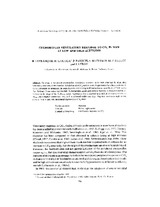Mostrar el registro sencillo del ítem
Chemoreflex ventilatory response to CO₂ in man at low and high altitudes
| dc.contributor.author | Lefrançois, R | |
| dc.contributor.author | Gautier, H | |
| dc.contributor.author | Pasquis, P | |
| dc.contributor.author | Cevaer, AM | |
| dc.contributor.author | Hellot, MF | |
| dc.contributor.author | Leroy, J | |
| dc.date.accessioned | 2019-04-25T18:08:43Z | |
| dc.date.available | 2019-04-25T18:08:43Z | |
| dc.date.issued | 1972 | |
| dc.identifier.uri | http://repositorio.umsa.bo/xmlui/handle/123456789/19949 | |
| dc.description.abstract | Abstract. On man, a peripheral chemoreflex ventilatory response curve was obtained by measuring ventilatory reactions to the transient inhalation of a CO₂-rich mixture. Experiments have been performed. 1) on lowlanders in normoxia, in acute hypoxia and during acclimatization at an altitude of 3660 m (La Paz, Bolivia). 2) on native highlanders. In lowlanders, acute and chronic hypoxia is characterized by an increase in the slope of the VE/PAco₂ curve. Acclimatization is marked by a shift of this curve to a lower PAco₂ and a higher ventilation. This shift is achieved within two days. Highland natives at high or low altitude have a very low peripheral chomoreflex CO₂ drive. | es_ES |
| dc.language.iso | en | es_ES |
| dc.publisher | Respiration Physiology | es_ES |
| dc.subject | ACLIMATACIÓN | es_ES |
| dc.subject | ALTURA | es_ES |
| dc.subject | CONTROL RESPIRACIÓN | es_ES |
| dc.subject | HIPOXIA | es_ES |
| dc.subject | NATIVOS DE GRAN ALTURA | es_ES |
| dc.title | Chemoreflex ventilatory response to CO₂ in man at low and high altitudes | es_ES |
| dc.type | Article | es_ES |

